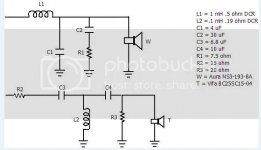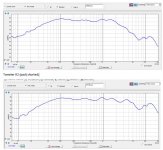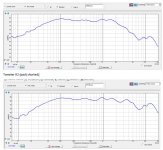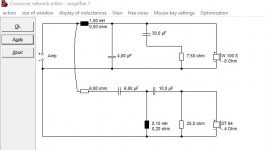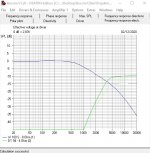My Harman Kardon Soundsticks have gotten flaky so I'm building some replacements per a thread on the Parts Express TechTalk forum Another salvo in the Micro-Monitor wars: The Dadiels -
Techtalk Speaker Building, Audio, Video Discussion Forum
I've assembled the XO's and drivers and listened, and the treble is rather reticent.
I'm guessing 4 - 5 dB more tweeter level will be in the ballpark; after that I can fuss with EQ if necessary.
Can I just decrease the value of the R2 padding resistor on the tweeter, or does that change the XO freq too?
Excerpt from post:
Try as I might, I could NOT get the phase to line up properly. I tried varying topologies, symmetrical, asymmetrical, 3kHz, 3.5kHz, on and on and on. No Joy. Either the FR was flat, or the phase was in line. Never both. So I left it alone for a couple of weeks. Meanwhile 50 Watt Head inquired about an improved crossover for the BR-1's. I told him that what he should do is take a look at the MurphyBlaster xo, but that I would take a shot at it. In the process of that, I got reacquainted with the Zobel network, and had a mini-brainstorm. "A Zobel! Why didn't I think of that?" So I went back into PCD, and entered a couple of random values as a Zobel, and immediately the phase came closer to lining up, and with a dip where there was a peak before! So, a little tweaking later, I wound up with the following crossover:
Techtalk Speaker Building, Audio, Video Discussion Forum
I've assembled the XO's and drivers and listened, and the treble is rather reticent.
I'm guessing 4 - 5 dB more tweeter level will be in the ballpark; after that I can fuss with EQ if necessary.
Can I just decrease the value of the R2 padding resistor on the tweeter, or does that change the XO freq too?
Excerpt from post:
Try as I might, I could NOT get the phase to line up properly. I tried varying topologies, symmetrical, asymmetrical, 3kHz, 3.5kHz, on and on and on. No Joy. Either the FR was flat, or the phase was in line. Never both. So I left it alone for a couple of weeks. Meanwhile 50 Watt Head inquired about an improved crossover for the BR-1's. I told him that what he should do is take a look at the MurphyBlaster xo, but that I would take a shot at it. In the process of that, I got reacquainted with the Zobel network, and had a mini-brainstorm. "A Zobel! Why didn't I think of that?" So I went back into PCD, and entered a couple of random values as a Zobel, and immediately the phase came closer to lining up, and with a dip where there was a peak before! So, a little tweaking later, I wound up with the following crossover:
Attachments
A bit of phase error is not the end of the world. 90 degree phase at crossover is called BW3 or Butterworth Third Order. A lot of small speakers use it.
I think you just reduce R2 from 15R to 10R for a start. Doesn't affect phase or frequency response much In my experience.
I think you just reduce R2 from 15R to 10R for a start. Doesn't affect phase or frequency response much In my experience.
From the overall sensitivity point of view, tweeter should be loud enough. I did find changing C3 to 3.3uF and C4 to 5.6uF might improve phase tracking in the x/o region extensively.
To be clear, the comments about phase are from the designer, and he seems satisfied that he addressed the issue.
My only concern is the treble level.
I did try 10 ohms and it helped, but wasn't sure what else it may have done after just a cursory listen to unbaffled drivers.
What I was really hoping for is for someone to see what happens using circuit design s/w.
Thanks
My only concern is the treble level.
I did try 10 ohms and it helped, but wasn't sure what else it may have done after just a cursory listen to unbaffled drivers.
What I was really hoping for is for someone to see what happens using circuit design s/w.
Thanks
We are all busy people. You might run Visaton Boxsim under windows:
Software | Visaton
Become a light unto yourself. The default project is quickly modified to your filter.
See how it works. Possibly the SC10N tweeter is close to what you have but a 4 ohm would be more accurate. If Lojzek has simmed your speaker, I might trust him. He is no mug. 😀
Software | Visaton
Become a light unto yourself. The default project is quickly modified to your filter.
See how it works. Possibly the SC10N tweeter is close to what you have but a 4 ohm would be more accurate. If Lojzek has simmed your speaker, I might trust him. He is no mug. 😀
Good to know about, thanks.
Actually I just found my misplaced OmniMic test disc, so now I can just measure what happens.
Actually I just found my misplaced OmniMic test disc, so now I can just measure what happens.
If I take on a project, I look for something similar to give me ideas.
Eekels' Mini
This isn't wildly different, is it? Usual metal/nextel driver breakup or ringing tank notch around 7kHz. It is a 8 ohm tweeter filter, so the caps are smaller and the coils bigger. But Mr Troels Gravesen usually knows what he is doing.
Eekels' Mini
This isn't wildly different, is it? Usual metal/nextel driver breakup or ringing tank notch around 7kHz. It is a 8 ohm tweeter filter, so the caps are smaller and the coils bigger. But Mr Troels Gravesen usually knows what he is doing.
Last edited:
That is the way to go, measuring will sort this more quickly. Perhaps driver polarity might make a difference. OP from PETT did not specify microphone position, driver offset while showing x/o parts and graphs and he made things a little more confusing mentioning to use Dayton Audio ND90's instead of Aura NS3 and the simulation was based on NS3.
Last edited:
> If I take on a project, I look for something similar to give me ideas.
> Eekels' Mini
? What I built isn't just similar, it's the exact design in the thread, including the ND90.
Anyway, it turns out that shorting the padding resistor gives the best response, there's still a bit of droop in the treble but acceptable.
Can anyone recommend some free/cheap basic EQ s/w I can use on my PC?
I may want to fuss with treble some more, as well as baffle step, as my cabinets are narrower than the ones the designer used.
> Eekels' Mini
? What I built isn't just similar, it's the exact design in the thread, including the ND90.
Anyway, it turns out that shorting the padding resistor gives the best response, there's still a bit of droop in the treble but acceptable.
Can anyone recommend some free/cheap basic EQ s/w I can use on my PC?
I may want to fuss with treble some more, as well as baffle step, as my cabinets are narrower than the ones the designer used.
Last edited:
Hi Brandon,
To what?
Though it looks pretty good as-is:
I would change R3 to get the least change in response.
To what?
Though it looks pretty good as-is:
Attachments
Whatever sounds good to your ear. Just pointing out that shunt resistors like that are ideal to shelve the whole level up or down with minimal impact on response shape. I often use one around that value as a median so people can remove it for a higher level, or try 10-15 ohm for a lower level. Using a series resistor to do that changes the response shape too much, as you discovered.
Using a series resistor to do that changes the response shape too much, as you discovered.
I guess I lucked out; so rare!
Aurasound NS3-193-8A 3" Extended Range Driver 8 Ohm:
Aurasound NS3-193-8A 3" Extended Range Driver 8 Ohm
Vifa BC25SC55-04 1" Square Frame Tweeter 4 ohm:
Peerless by Tymphany BC25SC55-04 1" Square Frame Tweeter
Sorry, Noah, I thought you were the designer. Hence the misunderstanding.
I ran a sim in Boxsim with similar drivers and it behaved as expected adjusting R2 down from 15R. But 10R only gave 3dB. 6.8R gave 5dB tweeter boost. But the tweeter slope and phase was unaffected, as I did expect. So I think that largely answers the question.
Can't say whether the design is any good, because I don't have any FRD or ZMA files. But I notice the woofer has significant metal breakup at 7.5kHz which you'd normally notch.
Aurasound NS3-193-8A 3" Extended Range Driver 8 Ohm
Vifa BC25SC55-04 1" Square Frame Tweeter 4 ohm:
Peerless by Tymphany BC25SC55-04 1" Square Frame Tweeter
Sorry, Noah, I thought you were the designer. Hence the misunderstanding.
I ran a sim in Boxsim with similar drivers and it behaved as expected adjusting R2 down from 15R. But 10R only gave 3dB. 6.8R gave 5dB tweeter boost. But the tweeter slope and phase was unaffected, as I did expect. So I think that largely answers the question.
Can't say whether the design is any good, because I don't have any FRD or ZMA files. But I notice the woofer has significant metal breakup at 7.5kHz which you'd normally notch.
Attachments
Last edited:
R2=15 Ohms, L2=0.1 mH. I guess the tweeter losts very high frequencies (cymbals, music triangles). A 1uF capacitor bypass R2 may help.
But I notice the woofer has significant metal breakup at 7.5kHz which you'd normally notch.
I measured the drivers separately; the woofer is down over 40 dB up there.
R2=15 Ohms, L2=0.1 mH. I guess the tweeter losts very high frequencies (cymbals, music triangles). A 1uF capacitor bypass R2 may help.
Not sure I understand.
R2 (which I'm going to remove) seems to just affect overall level, and L2 shunts low freq to ground.
Hi Noah,
can you explain the high frequency roll-off and how exactly did you perform measurements. I am not quite certain what to think of it. I would advise to make a tweeter only (without x/o) measurement as one file, then woofer only (without x/o) measurement as 2nd file, then tweeter only with x/o as 3rd file and finally woofer only with x/o as 4th file. These would be measured with microphone on a fixed position, then you could evaluate these by aligning one over the other.
can you explain the high frequency roll-off and how exactly did you perform measurements. I am not quite certain what to think of it. I would advise to make a tweeter only (without x/o) measurement as one file, then woofer only (without x/o) measurement as 2nd file, then tweeter only with x/o as 3rd file and finally woofer only with x/o as 4th file. These would be measured with microphone on a fixed position, then you could evaluate these by aligning one over the other.
- Home
- Loudspeakers
- Multi-Way
- Need help to modify XO
